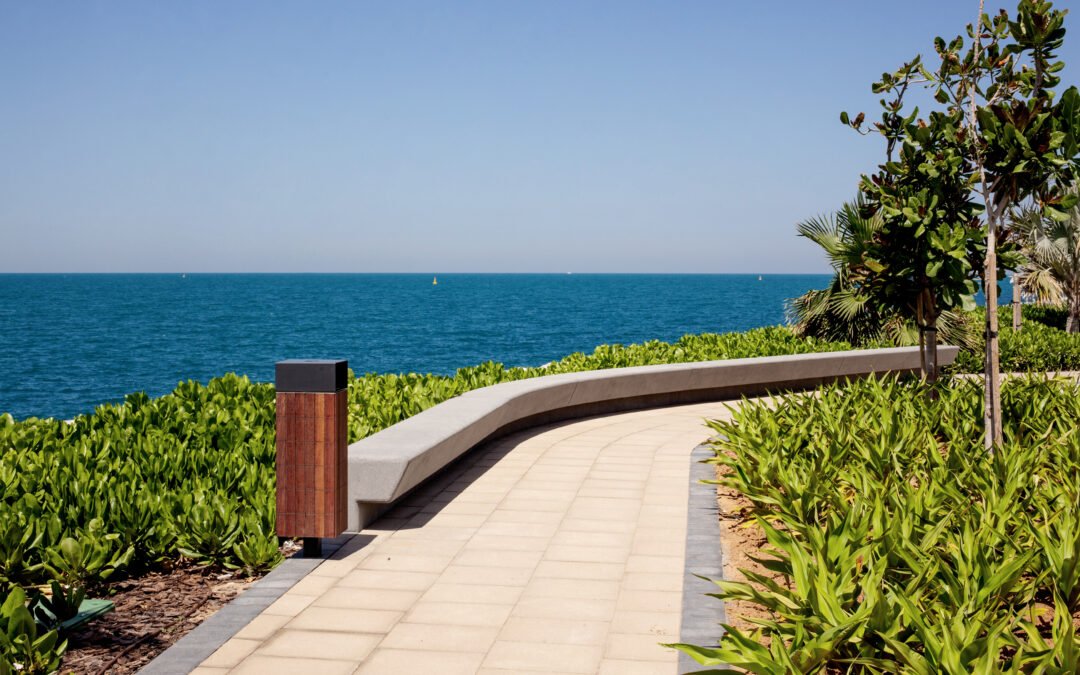Living by the coast offers breathtaking views and fresh sea breezes, but it also presents unique challenges for landscaping. Coastal landscaping and design require careful selection of plants, materials, and irrigation techniques to ensure your outdoor space remains lush and vibrant despite the harsh coastal conditions.
Why Coastal Landscaping Requires Special Consideration
The coastal environment presents several factors that impact landscaping choices, including:
- Salt Exposure: High salt content in the air and soil can damage traditional plants and turf.
- Wind Resistance: Strong coastal winds can erode soil and harm delicate plants.
- Drought Conditions: Coastal areas often experience long dry periods, requiring drought-resistant solutions.
- Sandy Soil: Poor nutrient retention in sandy soils necessitates specialized lawn care strategies.
- Humidity and Fungal Growth: Coastal humidity can promote fungal diseases, requiring proper plant selection and spacing.
Key Elements of Coastal Landscaping and Lawn Care
Choosing Salt-Tolerant Plants
Selecting plants that can thrive in salty conditions is crucial for a successful coastal landscape. Some of the best options include:
- Grasses: Seashore paspalum, zoysia grass, and Bermuda grass.
- Shrubs: Oleander, wax myrtle, and juniper.
- Flowers: Beach sunflower, lantana, and seaside goldenrod.
- Trees: Palm trees, live oaks, and southern magnolia.
Implementing Proper Drainage Systems
Since coastal regions experience occasional heavy rainfall, efficient drainage solutions are necessary:
- Install French drains or permeable pavers to facilitate water movement.
- Use raised garden beds to prevent waterlogging.
- Add organic matter to sandy soils to improve water retention.
Protecting Against Erosion
Coastal areas are prone to soil erosion due to wind and water forces. Strategies to combat erosion include:
- Planting deep-rooted vegetation to stabilize soil.
- Installing retaining walls and erosion-control fabrics.
- Using ground covers like creeping juniper to prevent soil displacement.
Comparative Analysis: Lawn Care in Coastal vs. Inland Areas
| Feature | Coastal Landscaping | Inland Landscaping |
|---|---|---|
| Salt Tolerance | High – requires special plants | Low – standard plants work |
| Wind Resistance | Essential for plant health | Less concern |
| Soil Type | Sandy, drains quickly | Rich, retains nutrients |
| Water Requirements | Moderate to high | Moderate |
| Pest Resistance | Requires salt-tolerant plants | More standard pest control |
Coastal Landscaping and Irrigation Solutions
Efficient irrigation is crucial for maintaining a healthy coastal landscape. Some options include:
- Drip Irrigation: Delivers water directly to the roots, reducing waste and evaporation.
- Smart Irrigation Systems: Sensors adjust watering based on weather conditions.
- Mulching: Helps retain moisture and regulate soil temperature.
- Rainwater Harvesting: Collecting and reusing rainwater can be an eco-friendly irrigation solution.
Coastal Landscaping and Garden Center Tips
A well-equipped coastal garden center can provide essential products and guidance, such as:
- Salt-resistant fertilizers and soil conditioners.
- Organic soil amendments to enhance sandy soil.
- Durable outdoor décor and hardscaping materials like stone and weather-resistant wood.
- Expert advice on plant selection, pest control, and ongoing maintenance.
Design Ideas for Coastal Landscapes
Transforming your coastal property into a paradise requires creativity and thoughtful planning. Consider the following ideas:
- Beach-Themed Pathways: Use crushed shells, driftwood, or natural stones for scenic walkways.
- Resilient Ground Covers: Creeping thyme and ornamental grasses add visual appeal.
- Outdoor Living Spaces: Incorporate pergolas and shade structures for comfort.
- Sustainable Landscaping: Utilize native plants that require minimal resources.
- Rock Gardens: Feature drought-resistant plants with decorative stones for a modern aesthetic.
Seasonal Coastal Landscaping Maintenance
Maintaining a coastal landscape requires a strategic approach depending on the season:
- Spring: Fertilize salt-tolerant plants and check irrigation systems.
- Summer: Monitor for pests, apply mulch to retain moisture.
- Fall: Trim back growth and add organic compost.
- Winter: Protect sensitive plants from occasional cold spells.
Conclusion
Coastal landscaping and design require specialized knowledge to combat the unique challenges of salt, wind, and sandy soil. By selecting the right plants, utilizing efficient irrigation techniques, and maintaining a strategic lawn care plan, you can create a beautiful and resilient seaside outdoor space.
At Evergreen Landscape FL, we specialize in coastal landscaping solutions that thrive in the challenging conditions of coastal living. Contact us today to transform your outdoor space into a stunning coastal retreat!living. Contact us today to transform your outdoor space into a stunning coastal retreat!

